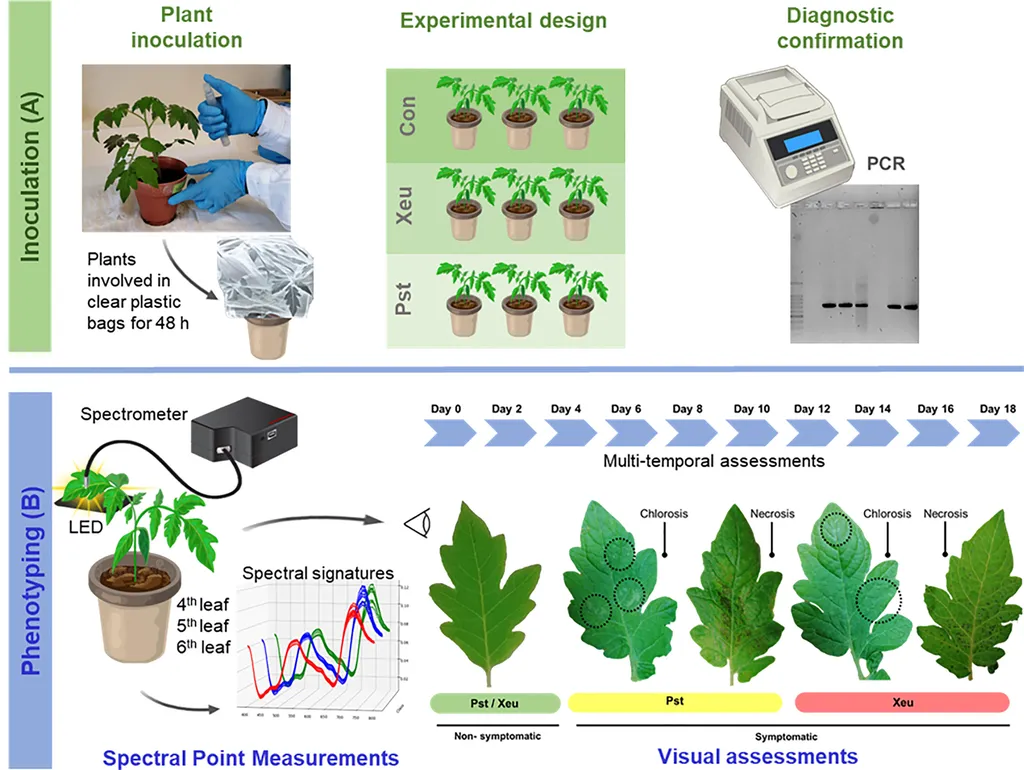In the heart of Xinjiang, China, a groundbreaking study led by Guifu Ma from the Research Institute of Agricultural Mechanization at the Xinjiang Academy of Agricultural Sciences is revolutionizing the way we detect and manage tomato fungal diseases. The research, published in the journal ‘Sensors’ (which translates to ‘传感器’ in Chinese), introduces a novel hybrid technique that combines hyperspectral imaging with few-shot learning, offering a promising solution for early and accurate disease detection in tomato plants.
The study focuses on four major fungal diseases that plague tomato crops: Alternaria alternata, Alternaria solani, Botrytis cinerea, and Fusarium oxysporum. These diseases can devastate yields, leading to significant economic losses for farmers. Traditional detection methods often rely on visual inspections, which can be time-consuming and inaccurate, especially in the early stages of infection. Moreover, building large annotated datasets for disease classification is often costly and time-consuming, requiring expert input.
Ma and his team addressed these challenges by integrating few-shot learning with hyperspectral imaging. “Our approach leverages the strengths of both spectral imaging and deep learning for robust detection with minimal data,” Ma explained. The proposed method involves three main steps: preprocessing of hyperspectral image cubes, deep feature extraction using the EfficientNet model, and classification using Manhattan distance within a few-shot learning framework.
The results are impressive. The few-shot learning approach achieved high detection accuracies of 85.73% for Alternaria alternata, 80.05% for Alternaria solani, 90.33% for Botrytis cinerea, and 82.09% for Fusarium oxysporum, based on data collected on Day 7 post-inoculation using only three training images per class. “Accuracy improved over time, reflecting the progressive nature of symptom development and the model’s adaptability with limited data,” Ma noted.
One of the most significant findings is the model’s ability to detect infections up to two days before visual symptoms emerge. For instance, Alternaria alternata and Botrytis cinerea were reliably detected by Day 3, while Alternaria solani and Fusarium oxysporum reached dependable detection levels by Day 5. Routine visual assessments showed that Alternaria alternata and Botrytis cinerea developed visible symptoms by Day 5, whereas Alternaria solani and Fusarium oxysporum remained asymptomatic until Day 7.
This research has profound implications for precision agriculture. Early detection of diseases allows for timely intervention, reducing the need for pesticides and minimizing crop losses. “Our method offers a practical solution for precision agriculture, enabling farmers to take proactive measures before diseases spread,” Ma said.
The commercial impact of this research is substantial. In the energy sector, where agricultural biomass is increasingly used for bioenergy production, ensuring healthy crops is crucial. Early detection of diseases can prevent contamination of biomass, ensuring a consistent and high-quality supply for energy production.
Looking ahead, this study paves the way for further advancements in the field. The integration of few-shot learning with hyperspectral imaging could be extended to other crops and diseases, enhancing the overall efficiency and sustainability of agricultural practices. As Ma and his team continue to refine their technique, the future of precision agriculture looks brighter than ever.
In the words of Ma, “This is just the beginning. We are excited about the potential of our method and its implications for the future of smart agriculture.” With such innovative research, the dream of sustainable, high-yield agriculture is becoming a reality.

